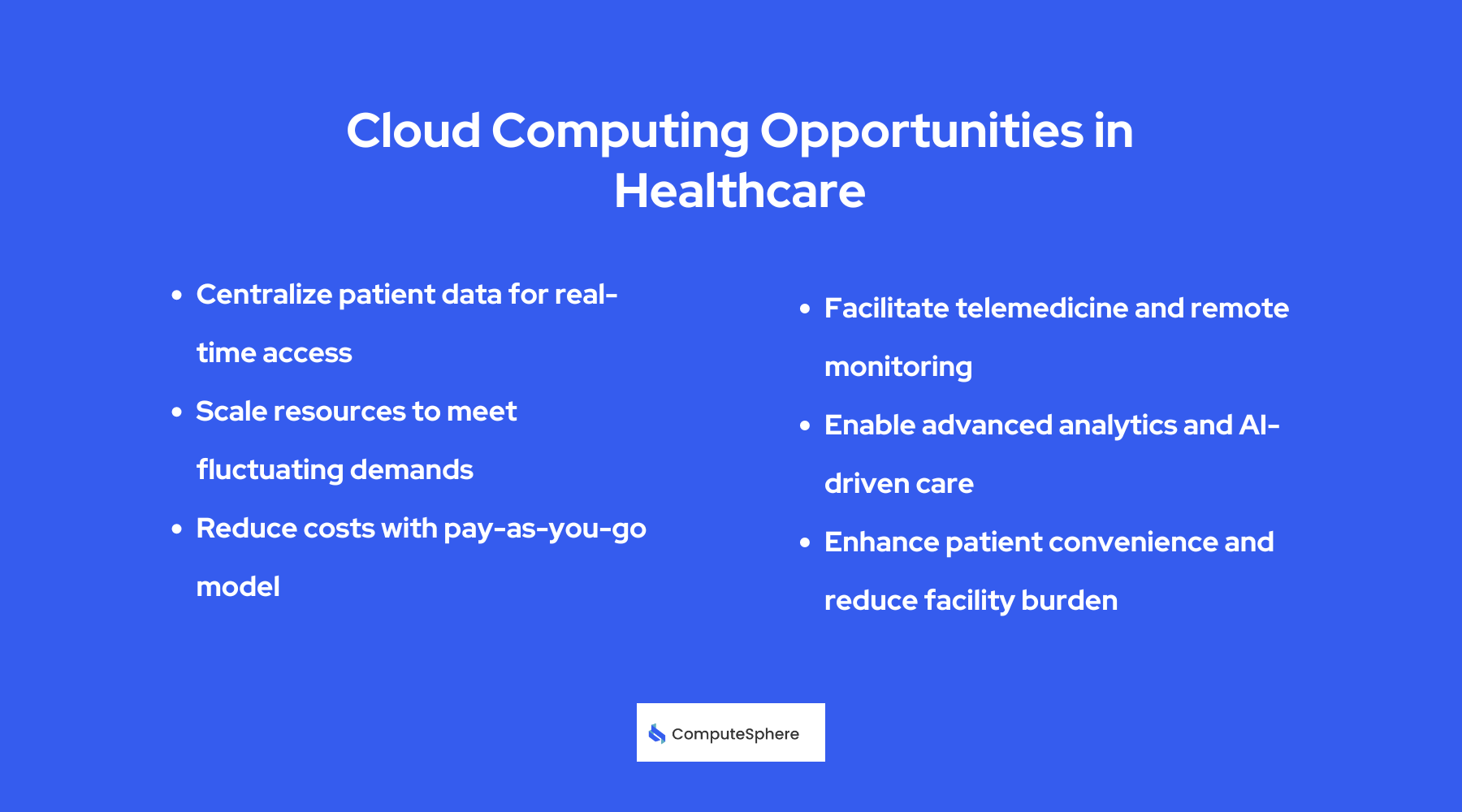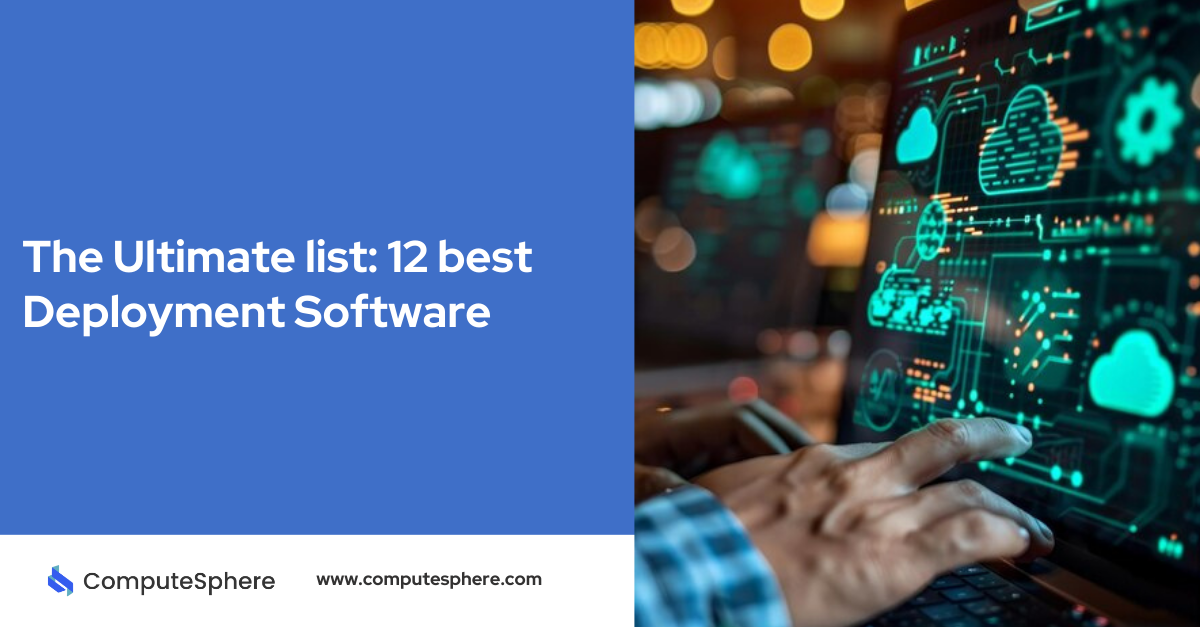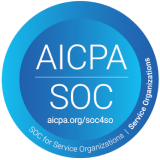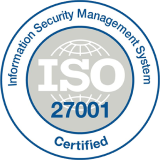Cloud Computing in Healthcare: Opportunities, Challenges, and Security

Cloud computing has changed many industries, including healthcare. This technology has enabled the way for innovative solutions that improve patient care, streamline operations, and reduce costs. By improving scalable resources and real-time data access, cloud computing addresses many of the long-lasting challenges faced by healthcare providers. As we look into the opportunities, challenges, and security aspects of cloud computing in healthcare, it becomes clear that this technology is not just a trend but a transformative force in modern medicine.
In this article, we’ll explore cloud computing opportunities, challenges, and securities in healthcare. So, let’s begin!
Cloud Computing Opportunities in Healthcare

Enhanced Data Management and Accessibility
Cloud computing greatly benefits healthcare by improving data management and accessibility. Traditionally, storing patient records in physical files or various electronic systems made accessing and sharing information difficult. With cloud computing, healthcare providers can centralize patient data, accessing real-time information from any location. This seamless data sharing improves collaboration among healthcare professionals, leading to better patient outcomes.
Scalability and Flexibility
Healthcare organizations often struggle with the fluctuating demand for computing resources. Cloud computing gives unparalleled scalability and flexibility, enabling providers to handle large volumes of data and adjust resources based on current needs. For instance, during a health crisis or seasonal flu outbreaks, hospitals can quickly increase their computing power to manage the increased patient load without significant initial investments in hardware.
Cost Efficiency
The cost efficiency of cloud computing is very significant. By moving to the cloud, healthcare organizations can reduce the need for expensive on-premises hardware and the associated maintenance costs. The pay-as-you-go model of cloud services allows hospitals and clinics to pay only for the resources they use, optimizing their IT budgets. This financial flexibility is particularly beneficial for smaller practices that may not have the capital to invest in extensive IT infrastructure.
Telemedicine and Remote Monitoring
Cloud computing has greatly facilitated the rise of telemedicine and remote patient monitoring. Healthcare providers can now offer virtual consultations, remote diagnostics, and continuous monitoring of chronic conditions, giving patients access to healthcare services from the comfort of their homes. This improvement not only improves patient convenience but also reduces the burden on healthcare facilities.
Advanced Analytics and AI Integration
Cloud computing provides the foundation for advanced analytics and artificial intelligence (AI) applications in healthcare. Predictive analytics can help identify patients at risk of developing certain conditions, allowing for early intervention. AI-driven tools can assist in diagnostics, treatment planning, and personalized medicine, leading to more accurate and efficient care.
Cloud Computing Challenges in Healthcare
Data Privacy and Security Concerns
Despite its numerous advantages, cloud computing in healthcare comes with significant challenges, particularly in terms of data privacy and security. Protecting sensitive patient information is very important, and any breach can have severe consequences. Healthcare organizations must ensure compliance with strict regulations such as HIPAA in the United States and GDPR in Europe. Implementing strong security measures to safeguard data is essential.
Interoperability Issues
Interoperability remains a critical challenge in healthcare IT. Integrating distinct systems and ensuring seamless data exchange between different healthcare providers can be complex. Standardization of data formats and communication protocols is necessary to achieve true interoperability and maximize the benefits of cloud computing.
Reliability and Downtime
The reliability of cloud services is another concern for healthcare providers. Ensuring constant availability of services is crucial, as any interruptions can disrupt patient care. Healthcare organizations must have contingency plans in place to address potential service outages and maintain continuity of care.
Cost of Implementation and Maintenance
While cloud computing offers cost savings in the long run, the initial setup and training costs can be significant. Transitioning to cloud-based systems requires careful planning, investment in new technologies, and staff training. Additionally, ongoing maintenance and updates are necessary to keep the systems secure and efficient.
Resistance to Change
Adopting new technologies often faces resistance from healthcare professionals accustomed to traditional methods. Overcoming this resistance requires effective change management strategies, including education and training to demonstrate the benefits of cloud computing and address any concerns.
Cloud Security Concerns
Regulatory Compliance
Ensuring regulatory compliance is a top priority for healthcare organizations using cloud computing. Regular audits and assessments are necessary to verify adherence to regulations such as HIPAA and GDPR. Maintaining compliance helps protect patient data and build trust with stakeholders.
Data Encryption and Access Controls
Data encryption is crucial for protecting patient information both in transit and at rest. Implementing strong encryption protocols ensures that data remains secure, even if intercepted. Additionally, role-based access control (RBAC) limits access to sensitive data based on job roles, further enhancing security.
Threat Detection and Response
Advanced monitoring systems are essential for detecting and responding to potential security threats. Healthcare organizations should implement advanced threat detection tools that can identify unusual activity and trigger alerts. Having a well-defined incident response protocol ensures that any breaches are quickly addressed and mitigated.
Disaster Recovery and Backup
Ensuring data backup and maintaining a comprehensive disaster recovery plan is crucial for preserving data integrity and availability. Regularly backing up data and using geographically dispersed data centers protect against data loss and ensure continuity of operations during a disaster.
Security Best Practices
Educating healthcare staff on cybersecurity best practices is an ongoing effort. Implementing multi-factor authentication (MFA) adds an extra layer of security, reducing the risk of unauthorized access. Regular training sessions and security drills help keep staff informed and prepared.
Future Trends in Cloud Computing for Healthcare
AI and Machine Learning in Cloud Healthcare
The integration of AI and machine learning with cloud computing holds great potential for the future of healthcare. Emerging applications include AI-driven diagnostics, personalized treatment plans, and predictive analytics for disease prevention. These innovations have the potential to transform patient care and improve outcomes.
Blockchain for Enhanced Security
Blockchain technology offers potential solutions for enhancing data security and integrity in healthcare. By creating permanent records, blockchain can help prevent data tampering and ensure the authenticity of patient information. This technology could play a significant role in addressing security challenges in cloud computing.
Edge Computing and IoT Integration
The integration of edge computing and the Internet of Things (IoT) with cloud computing can improve real-time data processing and reduce response time. Edge computing allows data to be processed closer to the source, enhancing the efficiency and reliability of healthcare applications. IoT devices, such as personal health monitors, can provide continuous data streams for better patient management.
Conclusion
Cloud computing offers transformative opportunities for the healthcare industry, from improved data management and cost efficiency to advanced analytics and telemedicine. However, it also presents challenges, including data privacy concerns, compatibility issues, and resistance to change.
By addressing these challenges and implementing strong security measures, healthcare organizations can fully utilize the potential of cloud computing. As technology grows, the future of healthcare seems inspiring, with AI, blockchain, and Edge computing positioned to drive further innovation.
Contents
Built for Builders. Priced for Startups.
Tired of unpredictable cloud bills? ComputeSphere offers modular, fixed-cost cloud hosting that grows with your startup—no DevOps headaches, no surprises.
Get StartedShare this article
Browse Some Related Blogs
Relevant and related contents you can read









